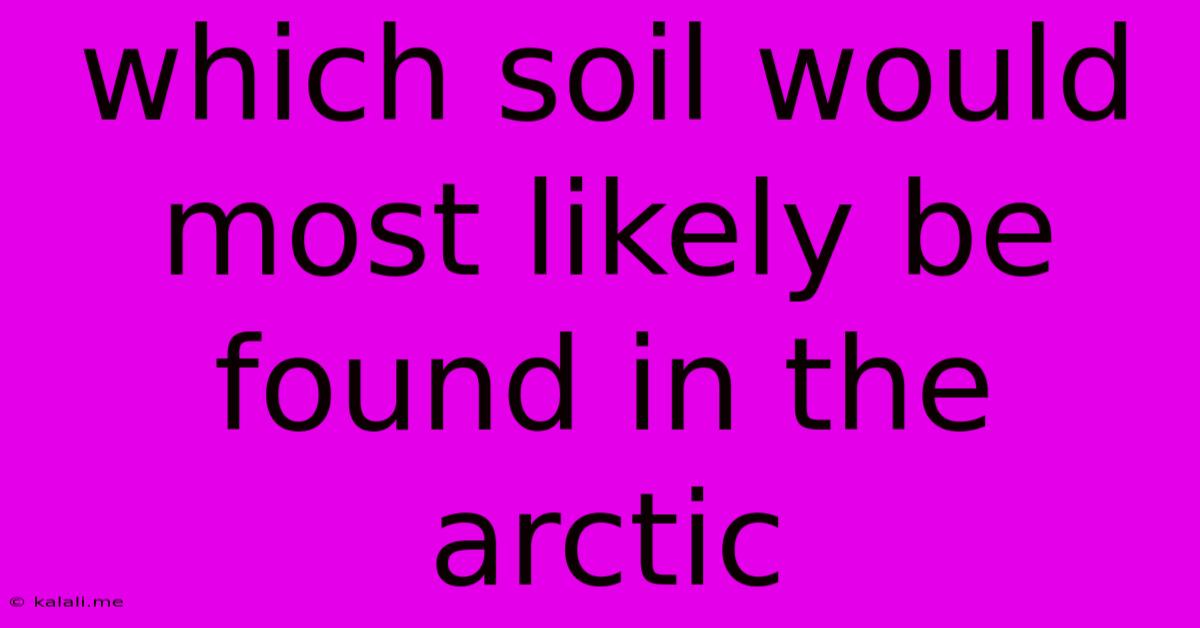Which Soil Would Most Likely Be Found In The Arctic
Kalali
May 09, 2025 · 3 min read

Table of Contents
Which Soil Would Most Likely Be Found in the Arctic? Unlocking the Secrets of Arctic Soils
The Arctic, a land of extreme cold and limited growing seasons, boasts a unique soil type significantly different from soils found in temperate or tropical regions. Understanding the characteristics of Arctic soils is crucial for comprehending the region's delicate ecosystem and its vulnerability to climate change. This article explores the dominant soil type found in the Arctic, its formation, and its key properties.
Understanding Arctic Soil Formation: A Slow and Cold Process
Arctic soil formation is a slow and challenging process, heavily influenced by the region's permafrost, a permanently frozen layer of soil beneath the surface. This permafrost acts as a significant barrier to water drainage and nutrient cycling, shaping the characteristics of the overlying active layer, the soil layer that thaws seasonally. The short growing season and low temperatures restrict the decomposition of organic matter, leading to the accumulation of peat and organic debris. These factors combine to create a unique soil profile distinct from other climatic zones.
Gelisols: The Predominant Soil Type in the Arctic
Gelisols are the most prevalent soil type found in the Arctic. These soils are characterized by the presence of permafrost within one meter of the surface. The slow decomposition rates mentioned above result in a significant accumulation of organic matter, often forming thick layers of peat or other organic materials. The slow decomposition also means that nutrients are locked up within this organic material, making them less available for plant growth compared to other soil types.
Key Characteristics of Gelisols:
- Permafrost: The defining feature, influencing nearly all other properties.
- High Organic Matter Content: Accumulation of partially decomposed organic matter due to slow decomposition rates.
- Cryoturbation: Disturbance of soil layers due to frost heave and thawing, creating a patterned ground. This process can mix different soil horizons and create unique soil structures.
- Low Nutrient Availability: Slow decomposition processes lead to a limited release of nutrients.
- Waterlogged Conditions: Permafrost impedes drainage, leading to saturated or waterlogged conditions in many areas. This further impacts nutrient cycling and plant growth.
- Ice-Rich: Gelisols frequently contain significant amounts of ice, either as segregated ice lenses or within the soil matrix itself. This ice contributes to the unique physical properties of the soil.
- Slow Decomposition: microbial activity and decomposition are significantly slowed by the frigid temperatures, leading to organic matter accumulation.
Other Soil Types in the Arctic
While Gelisols are dominant, other soil types can be found in specific Arctic locations, such as:
- Inceptisols: Found in areas with better drainage and slightly warmer conditions than those typical of Gelisols.
- Histosols: Peat soils, which can be very extensive in specific areas, especially in wetlands.
The Impact of Climate Change on Arctic Soils
Climate change poses a significant threat to Arctic soils. Rising temperatures are leading to permafrost thaw, which can result in several negative consequences:
- Increased Greenhouse Gas Emissions: Thawing permafrost releases large amounts of methane and carbon dioxide, exacerbating climate change.
- Soil Degradation: Thawing can lead to soil erosion, slumping, and changes in soil structure.
- Changes in Ecosystem Function: Altered soil conditions can affect plant communities and other aspects of the Arctic ecosystem.
Understanding the properties and vulnerabilities of Arctic soils, particularly Gelisols, is critical for developing effective conservation and management strategies in this sensitive environment. Further research into the impact of climate change on these soils is crucial for predicting and mitigating future consequences.
Latest Posts
Related Post
Thank you for visiting our website which covers about Which Soil Would Most Likely Be Found In The Arctic . We hope the information provided has been useful to you. Feel free to contact us if you have any questions or need further assistance. See you next time and don't miss to bookmark.